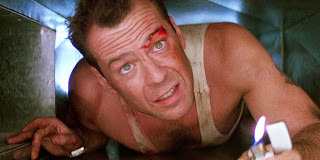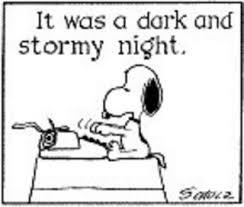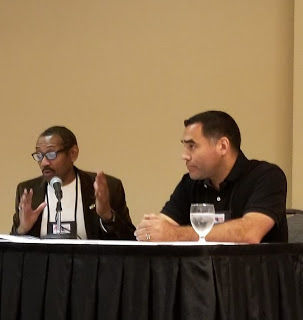Austin S. Camacho's Blog, page 5
November 13, 2018
Write Hard - Plotter vs Pantser examples
 Last week I introduced two different approaches to writing fiction: plotters (who like an outline) as opposed to pantsers (who write “by the seat of their pants.”) I thought it might be useful to give an example of how a plotter like me might approach writing a story.
Last week I introduced two different approaches to writing fiction: plotters (who like an outline) as opposed to pantsers (who write “by the seat of their pants.”) I thought it might be useful to give an example of how a plotter like me might approach writing a story.Perhaps we decide that a terrorist has a plan that begins with kidnapping a group of innocent people at a Christmas party. That’s really just a distraction because his real plan is to steal $640 million in bearer bonds from a vault in that building. We decide that a hero will get involved unintentionally. Then we plan each barrier the hero will face in stopping the villain, each bigger than the last, until the hero finally wins. [Yes, I’m writing Die Hard – from a plotter’s approach.] As I build that plotline, I’m deciding what kind of person would conceive of such an audacious plot. And I’m deciding what kind of hero would be both willing and able to thwart him. To an extent the plot tells me who the characters are.
So why be a pantser? Well I think the pantser likes to be surprised by where his narrative takes him. This is a writer who, instead of finding confidence in seeing the entire sequence before he starts writing, perhaps gets bored if he knows all that’s going to happen. He most likely starts with the characters and a situation.
So, imagine I want to write a story about a cop who’s a real cowboy, a wild card on the job who can’t keep his family life together. I want to show how this guy deals with a serious crisis and proves that he is, in fact, a hero at heart. Suppose I have him go to a Christmas party with his estranged wife. But then a bunch of terrorists takes over the building, endangering the still beloved wife. What will he do, how will he deal with this situation. And how will the villain, a worthy opponent, keep him on the edge of failure?
If a pantser wrote this story, he might not have any idea of the villain’s reason for crashing the Christmas party when he starts writing. But the characters tell him there’s more to it than simple hostage taking because this is a very smart bad guy.
So you can see how these two approached to storytelling could have created the same story. But what if the pantser story line doesn't work? Ahhh, that is a story for next week.
Published on November 13, 2018 15:01
November 6, 2018
Plotter or Pantser - Two Ways to Tell Your Story
PLOTTER OR PANTSER – TWO WAY TO TELL YOUR STORY
 Last weekend I was chatting with a room full of writers about our process. Every writer is different and one way is that some are "plotters" while others are "pantsers." I am a plotter.
Last weekend I was chatting with a room full of writers about our process. Every writer is different and one way is that some are "plotters" while others are "pantsers." I am a plotter. That doesn’t mean i have anything against the pantser community it’s just not the way I usually work. Here in my blog I will compare and contrast those two approaches to writing, not trying to decide if one path is better than the other, but rather to see which might be better for you, and to see the plusses and minuses of each.
To start we should define our terms. All writers use plots. But when I say “plotter” I mean a person who creates an outline before they begin creating prose. The outline is the sequence of events, the plot of the story they are writing. The outline is in effect the skeleton of the story. Once that is in place and solid, the writer puts the flesh on those bones in the form of written prose and dialog.
What I call a pantser is a writer who figuratively flies by the seat of his pants. This person begins to lay down his prose without knowing all the details of what will happen later on, or maybe not knowing any of what will happen. He is like a driver on a dark road at night. He can only see as far as the headlight beams go, but he trusts that there is more road out there ahead.
So why would you want to be a plotter? Well, are you a builder? I think for those of us who are more comfortable working from an outline the story starts with the events. We like to construct a neat puzzle or a tramatic sequence, one building block sitting neatly on the one before. We begin with a theoretical straight line from here to there, from the beginning to the end of the tale.
Next week we'll look at some examples of how a plotter works as opposed the the way a pantser works out a story. And please feel free to add your comments and questions!
Published on November 06, 2018 13:45
October 28, 2018
Starting Anew
 My next Hannibal Jones mystery is finished, and our content editor is working it over right now. But I am always writing. So as soon as I sent my Hannibal novel off to the editor I launched into the next project.
My next Hannibal Jones mystery is finished, and our content editor is working it over right now. But I am always writing. So as soon as I sent my Hannibal novel off to the editor I launched into the next project.I’ve been asked about the next Stark & O’Brien thriller, and there is interest in a sequel to Beyond Blue. Those were obvious choices. But a writer has to follow his muse, and sometimes a character will call to you.
Three years ago, I wrote a short story called “One of Us” for the anthology Insidious Assassins. The protagonist of that story was a Black female professional killer named Skye. In those 5,000 words we didn’t need to learn a great deal about Skye, not even a last name. But while I wrote two other novels this character was calling to me, wanting to explain herself better. Who was she? How had she become a stone-cold assassin? And how could she justify her actions so as not to see herself as a villain?
So, this week, I begin a new novel telling Skye’s story. I have an outline, but it is not nearly as detailed as mine usually are. Writing is moving very slowly because I am learning about Skye as I write. The character is deep, as they all are, but I have not seen the depth yet. What has surfaced is a brother who died of a drug overdose and a mentor who showed her the killing ropes.
Apparently murder-for-hire is a team sport. Just 4,000 words into the story a driver, an accountant and a computer expert have surfaced. Oh, and Skye turns out to be in therapy. I can see that’s going to be a complex situation, but the assassin has some unresolved issues she needs to address.
So, this book is building more slowly than everything I’ve done in the past, because while I know the general plot, how things will happen and how Skye will react to the events I foresee are still in flux. It’s going to be an interesting ride, which I look forward to sharing with you.
Published on October 28, 2018 16:54
October 22, 2018
Are Christian Writers Different?
 Saturday, I had the pleasure of teaching the basics of fiction at a small but vibrant writers conference. I’ve done it dozens of times before, but I wondered if it would be different this time. This was the Vines and Vessels Christian Writers Conference. Would I have to present differently? Would there be resistance to my messages?
Saturday, I had the pleasure of teaching the basics of fiction at a small but vibrant writers conference. I’ve done it dozens of times before, but I wondered if it would be different this time. This was the Vines and Vessels Christian Writers Conference. Would I have to present differently? Would there be resistance to my messages?As it turns out, I had a very welcoming and receptive audience. I explained that while I am a writer, and as it happens I am a Christian, I am not a Christian writer. I write to entertain my audience, to thrill them or engage their minds in a good mystery. Many of the people I spoke to Saturday write primarily to deliver a message, to reinforce or clarify biblical teachings.
Still, it has long been my belief that “Christian” is not a genre any more than Young Adult is. Christian writers have a specific audience, people who share certain values and are looking for a style and approach to writing. For example, they don’t want to worry about finding graphic sex, or violence or profanity in their reading. And they want to read about characters who believe as they do, and whose faith leads them to success.
That said, the key points that make for good dialog are the same whether you’re writing a mystery, a thriller, or Christian fiction. And the same applies to constructing a strong plot. One of my students Saturday shared that she wants to re-write King David’s story in a way that will appeal to today’s readers, but she wasn’t sure how to begin. We discussed clearly defining our protagonist and the antagonists in the story, where to start for a good hook, and how to build a story arc. We talked about finding the central conflict, and how to build suspense to keep people reading. By the end of the class everyone saw that the original Bible story followed all the rules I was giving them.
Ultimately every writer has the same desire: to have lots of people read their work. And many of us do have a statement to make through our fiction, be it political, social, or philosophical. Writers of Christian fiction may have some motivations the rest of us don’t, they need to use the same techniques of the craft to reach their audience and keep them reading to the end.
Published on October 22, 2018 18:55
October 16, 2018
Writing Reviews
 As an author I am always hoping my work will be reviewed. But in the meantime, I write them. I review other writers’ books for the Washington Independent Review of Books and for The Big Thrill, the magazine of the International Thriller Writers. Unlike working on my own fiction, reviews are written on deadline. So why do I take time away from working on my next novel to talk about someone else’s?
As an author I am always hoping my work will be reviewed. But in the meantime, I write them. I review other writers’ books for the Washington Independent Review of Books and for The Big Thrill, the magazine of the International Thriller Writers. Unlike working on my own fiction, reviews are written on deadline. So why do I take time away from working on my next novel to talk about someone else’s?For one thing, it provides great exposure. Every review I write appears on line with my byline and a short bio. They usually include a link to my web site. Because the reviews are part of a larger magazine they reach a huge audience. It’s one way for a large number of readers to find out about me and my books. It never hurts for your name to be all over internet.
It is also a great networking opportunity. My Washington Independent work puts me in contact with a team of movers and shakers in the DC writer community. My work with the editors of The Big Thrill makes me, de facto, a member of the ITW staff. In both cases, there are big advantages to these people knowing who I am and what I writer.
There is another, more subtle benefit to writing reviews. It forces you to deconstruct a variety of other authors’ work and through that process, learn more about the craft. Reviewing is much more than saying a book is good or bad. Beyond identifying the book’s genre and describing its content, you have to provide context. You have to be able to support your reaction to the book.
A good review explains what the author set out to do with that book and tells us whether or not he or she succeeded. It tells us how this book compares with similar books recently published. It lets us know what a reader can take away from the book. Most importantly, the review tells us whether or not the book is worth reading. Often you will note other issues or topics that SHOULD have been dealt with in the book. This kind of insight ultimately informs my own writing.
So, to get more exposure to reader, to become better known in the writing community, and to improve your own work, I recommend making the connections to start writing reviews. And, Oh, did I mention the free books?
Published on October 16, 2018 18:44
October 8, 2018
WHAT An Event! The C3 Con 2018
 Sunday we put a cap on the 6th annual Creatures, Crimes & Creativity Con and many said it was the best yet. More than 80 writers and avid readers gathered together to talk about the books we love: mystery, suspense, thriller, horror, sci-fi, fantasy and paranormal fiction. We had some pretty impressive keynote speakers in Jamie Frevelettiand Keith DeCandido but the event didn’t hang on them alone. And everyone gets a swag bag full of goodies but I don’t think people come for that. So what makes a geat small literary Convention?
Sunday we put a cap on the 6th annual Creatures, Crimes & Creativity Con and many said it was the best yet. More than 80 writers and avid readers gathered together to talk about the books we love: mystery, suspense, thriller, horror, sci-fi, fantasy and paranormal fiction. We had some pretty impressive keynote speakers in Jamie Frevelettiand Keith DeCandido but the event didn’t hang on them alone. And everyone gets a swag bag full of goodies but I don’t think people come for that. So what makes a geat small literary Convention?I think a feeling of togetherness and community is key. We emphasize this by maintaining a Facebook page - https://www.facebook.com/groups/452670518248659/- that is a year-round place for genre fiction writers and their fans & readers to share news, opinions and idea. We support and enlighten one another, and it doesn’t matter if you’re a NY Times bestseller or just trying to get that first book out.
To further promote togetherness, all meals are included in the registration fee. That means almost everyone eats together. There are no assigned seats so fans and avid readers
As one of the organizers I work at showcasing the authors. That means that the two keynote speakers are treated… well not like kings, but maybe like the honored matriarchs or patriarchs of a big family. Each gives a dinner keynote speech and if they’re willing they offer a class to the group. They are on panels with the other writers which further heightens the feeling of community.
We interview our two local guest authors (John DeDakis and Ed Aymer who is pictured with me) in order to highlight their talents but also give them a chance to share their journey, how they got to where they are in their careers. By holding them up as examples we make them feel special.
Of course the core of the event is panels, and all published authors present on them. Best sellers sit beside newbies. In other ways we promote authors as much as we can. Both groups’ books are available for signing and sale at our two book signings. We list all their names and links on the C3 website, and we picture them all in the C3 program book.
To further focus on our writers we get the Baltimore County Public Library’s video team to shoot interviews. Sure, interviews of the big names are good for promotion, but for everyone else it’s a chance to feel like a star, a taste of the big-name life.
The new addition this year was Noir at the Bar, a reading series that takes place all over the world. In this case, ten of the attending authors read short stories, novel excerpts and in one case, a Halloween story set in an epic poem.
We love our little conference, but more, we love the little community that has grown around it. That, more than anything else, is what makes the Con great! Take a look at what we offered this year, and soon more about next year, on our website – www.creaturescrimesandcreativity.com
Published on October 08, 2018 17:44
September 23, 2018
Is It Finished?
 I have completed the draft of my next Hannibal Jones novel, currently titled The Wrong Time. Or at least I think I have. But then, I thought it was finished two weeks ago.
I have completed the draft of my next Hannibal Jones novel, currently titled The Wrong Time. Or at least I think I have. But then, I thought it was finished two weeks ago.I typed “The End” and declared victory then. The story worked, the characters worked, and after three thorough rewrites I was happy with the prose. I ran spell checks and grammar checks. I sent the book to first readers. Done.
Then I started seeing this scene in the book. It was one of those bridging scenes, like connective tissue, to get the reader from one place in the plot to another. There was movement, there was dialog and the setting was an easy wraparound. But it kept appearing in my mind, playing over and over like a slice of a movie.
Then my brain started changing the scene. Reformatting it. Characters doing and saying different things. Seeing it from different camera angles. I had to accept that my mind was still writing. I was still in that book. But why?
Then I realized that part of the dialog included Hannibal being told something important. And there it was. The scene was wrong because it was lazy. Hannibal was told something he should have seen for himself and, by extension, the reader should have seen.
It wasn’t bad. It wasn’t broken. It just wasn’t as good as it could have been. It was weak. It didn’t flow with the rest of the book. Improvement would mean cutting that scene and writing a new one. That necessitated rewriting the previous scene, leading up to the one being rewritten. It called for reimagining the events that took place that day in three characters lives. It changed their experiences and memories of that day. It rippled through dialog and thoughts expressed later in the book.
So, I’ve done all of that rewriting and rethinking. And now the book is really, truly finished.
I think.
Published on September 23, 2018 13:52
September 16, 2018
Writing Contests
 As the editorial director of Intrigue Publishing I submit our books for various contests. Today I got to send five of our latest releases to the International Thriller Writers for their annual awards. Could one of our novels be chosen as best paperback original or first novel of the year? And what if they are? While I believe that one of our books really might be the best thriller of the year, I harbor no illusions that we are likely to beat out the publishing giants who send all their books in as well (unless one year Deaver, Gilstrap, Heather Graham, et al decide to take a year off writing.) However, the judging is blind and there are tons of books to judge so you never know when an unknown might get placed on the list of nominees. I say this from experience: I was one of the paperback judges one year and it is a monumental job! But aside from ego gratification, what does an author get from such contests.
As the editorial director of Intrigue Publishing I submit our books for various contests. Today I got to send five of our latest releases to the International Thriller Writers for their annual awards. Could one of our novels be chosen as best paperback original or first novel of the year? And what if they are? While I believe that one of our books really might be the best thriller of the year, I harbor no illusions that we are likely to beat out the publishing giants who send all their books in as well (unless one year Deaver, Gilstrap, Heather Graham, et al decide to take a year off writing.) However, the judging is blind and there are tons of books to judge so you never know when an unknown might get placed on the list of nominees. I say this from experience: I was one of the paperback judges one year and it is a monumental job! But aside from ego gratification, what does an author get from such contests.I don’t honestly think readers really care if your book wins an ITW award, or an Edgar award or a Bram Stoker or a Hugo. I don’t think these awards do much for sales – at least not directly.
What they DO nudge is the industry’s opinion of a writer. Winning one of these awards makes publishers, agents and editors view you differently. They make reviewers more likely to comment on your next work. They make book sellers more likely to want to carry your books. So, they do matter.
These awards also give the publisher a boost. A big win like the ITW awards would enhance our brand in the eyes of all those same industry professionals. It says we know how to pick a winner. It shines a positive light on all the rest of our line. We have had books win conference awards (the Love is Murder Lovey, the Deadly Ink best mystery award, etc.,) so now we’re chasing the bigger wins.
Writers should not be misled by awards that require them to pay a fee to be considered. Because entrants are only competing against others who decided to pay that fee, being named “best” has much less value. Industry professionals pay little attention to those contests.
So, authors, get your books up for the important awards, and encourage your publisher to put you on those lists. And give me a comment if you’ve won something and let us know how it has affected your writing career.
Published on September 16, 2018 16:04
September 9, 2018
One Step Beyond
 Last week I posted a number of tips for building suspense, and here’s one more important one: Always be one step ahead of your readers.
Last week I posted a number of tips for building suspense, and here’s one more important one: Always be one step ahead of your readers.As you write you must constantly be asking yourself what your reader is hoping for or wondering about each point in the story. Your job is to give them what they want, when they want it – or maybe a little later than they want it – or to add a twist so you give them more than they bargained for. How do you do that?
1. As you develop your story, appeal to readers’ fears and phobias. Phobias are irrational fears, so to be afraid of a tarantula is not a phobia, but to be afraid of all spiders is. Most people are afraid of helplessness in the face of danger. Many are afraid of needles, the dark, heights and so on. Think of the things that frighten you most, and you can be sure many of your readers will fear them as well.
2. Make sure you describe the setting of your story’s climax before you reach that part of the story. This is necessary to protect your pacing. In other words, let someone visit it earlier and foreshadow everything you’ll need for readers to picture the scene when the climax arrives. Otherwise you’ll end up stalling out the story to describe the setting, when you should be pushing through to the climax.→3. As you build toward the climax, isolate your main character.Remove his tools, escape routes and support system (buddies, mentors, helpers or defenders). This forces him to become self-reliant and makes it easier for you to put him at a disadvantage in his final confrontation with evil.
4. Make it personal. Don’t just have a person get abducted—let it be the main character’s son. Don’t just let the whole city be in danger—let the protagonist’s grandma live there.
Work all those elements into your story, and you will give your readers a satisfying journey and always be one step ahead of them.
Published on September 09, 2018 13:34
September 2, 2018
The Promise of Suspense
 Last week I told you about creating suspense by promising things that will go wrong. My favorite scenes in the Star Wars movies grow from one inspired bit of dialog: Han Solo looks around and says, “I got a bad feeling about this.” Actually at least 5 different characters say that in the series but only Han Solo says it more than once.
Last week I told you about creating suspense by promising things that will go wrong. My favorite scenes in the Star Wars movies grow from one inspired bit of dialog: Han Solo looks around and says, “I got a bad feeling about this.” Actually at least 5 different characters say that in the series but only Han Solo says it more than once.When Scarlett O’Hara swears s he’ll never be hunger again. Marley tells scrooge he’ll be visited by 3 ghosts. Or in a romance story when a jilted lover says something like, “If I can’t have her nobody will,” That’s promising bad stuff. In the romance, maybe that guy hides in the bushes until his rival shows up. The bad guy pulls his knife. The good guy looks around, looks right at the bush but doesn’t see the bad guy hidden there. He turns his back to the bad guy… Yep! Milk that moment. That’s the suspense.
But make sure that eventually you show us what happens in front of that bush. You have got to keep every promise you make, and the bigger the promise, the bigger the payoff has to be. A huge promise without the fulfillment isn’t suspense—it’s disappointment. That’s why Frodo can’t simply pull off the ring and toss it. And Rocky can’t knock out Apollo Creed with a lucky punch in the third round. Every word in your story is a promise of some sort. If you spend a paragraph describing a woman’s fabulous shoes, those shoes better be vital to the story. The cliché is, if you show me a gun on the mantle in chapter 2, somebody better darned well aim that thing at someone before the books’ over.
Stories sometimes fail because the writers don’t make big enough promises, or they don’t fulfill them.
Another side of the promise concept is, let the characters tell readers their plans. That doesn’t mean give away all the secrets. It means show the reader the character’s agenda. Readers know something will go wrong because they know, on some level, that the story is about conflict. In the romance story I made up with the guy hiding in the bushes, that scene would be stronger if earlier we had heard the good guy tell the girl, “I’ll meet you by the bushes at 6 o’clock!” Now we’re not only worried about him getting stabbed, we also get to worry that she’ll see it, or that she might be the next victim.
I’ll share more on mastering suspense next week.
Published on September 02, 2018 14:00



